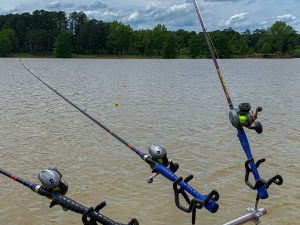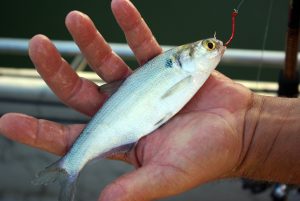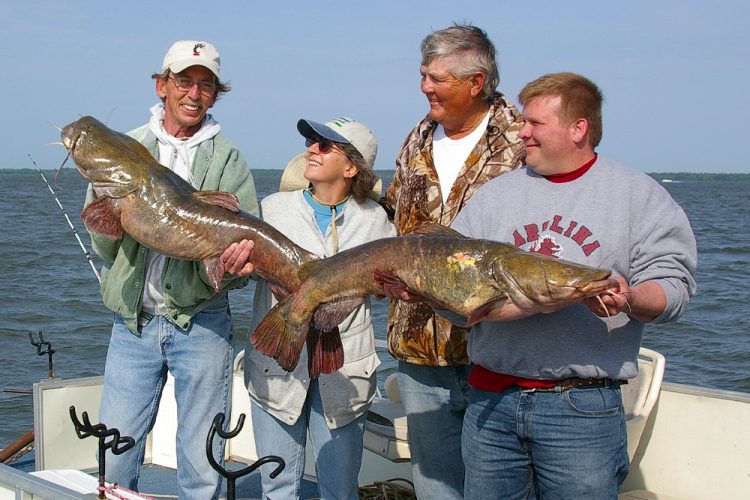Trolling works great for putting some dandy catfish in
the boat—winter, spring, summer and fall. (Photo by Keith Sutton)
Trolling for Catfish Year-Round
By Alan Clemons
Regardless of the season, you can catch more catfish if you use some of the simple tactics presented here.
My slip float bobbed once, twice and then went under by the knobby base of the cypress. Hall of Fame guide Billy Blakely and I were on Reelfoot Lake, many years ago, dabbling for bluegills around the trees and knobs. My bluegill zipped back and forth, flashing once at the surface of the tea-colored water. Then everything stopped.

The bluegill stopped moving. I figured it had snagged the point of the hook on a cypress knee. But I couldn’t feel it wiggling. Nothing. As I lifted the B’n’M pole to check, the wide, mottled shape and body of a long flathead catfish came into view. It had a firm clamp on my bluegill, with only the eyes and mouth showing, but not a hook in its tough lip. Blakely reached for the net. Too late. The big flathead turned, surged, broke off everything and swam into the dark water with my bluegill.
That incident, going on 20 years ago now, perfectly illustrates the importance of baitfish. The hungry catfish saw the flittering bluegill as bait. A big, tasty meal. That it was struggling indicated easier prey. The catfish took advantage of this. It left me momentarily stunned, then giddy like a kid having fun, but ultimately needing to tie on a new hook.
Knowing about baitfish is key to any kind of fishing. Whether it’s for catfish, bass and bluegills on a lake, or redfish, groupers and marlins in the salt, having insights on baitfish helps with catching anything. Baitfish make the fishing world go ‘round. Without them, there are no bigger fish. And the life cycle isn’t just about shad or bluegills for cats and big minnows for crappie. It starts with the base of the food chain—plankton—consumed by minnows and shad, which are eaten by bluegills and crappie, which are … and on and on.
Trolling for Catfish
Few things are as enjoyable as quietly drifting at slow speed for catfish, rods in the holders and lively minnows on hooks or tipped on jigs under floats. It may be in shallow cover, where blues, flatheads and channel cats cruise for food or could amid spawning rituals. Anchoring and dropping a gut sack or fillet sandwich is fun. Watching a sonar screen to identify any structure, cover and bait to troll over adds an extra dimension of fun.

One thing about trolling, though, is unless you’re using a line-counter reel, you may not be in the hot strike zone. Often, you’re close enough. Close sometimes does the job. But not always. In those situations, what if you could reliably, consistently put your bait at specific depth and stay there as you troll along a channel break or creek bend, over stumps, beside long riprap banks or near shady bridge pilings? Even better, what if you could locate the bait that catfish (or other species) are feeding on and hit that depth every time? Or perhaps, you figure out the thermocline and combine all of this juice into one big squeeze?
Trolling accessories such as planer boards, planer releases, line clips, downriggers, divers and weights all can help achieve these goals. They’re not difficult to use. It just takes time to figure out the proper rigging, weights and speeds for drifting.
That sounds like a lot, but it’s really not. The first time I saw any kind of planers and downriggers used was on Lake Michigan more than 25 years ago for salmon. The captain had big weights, clips, lines and colorful spoons. It was August and the salmon and bait were deep. We caught the heck out of them all morning. Since then, I’ve fished with planer boards and downriggers for catfish, crappie and saltwater species, all with success.
The cool thing about using downriggers, planer boards and other trolling accessories is you can do it almost all year. Ice anglers, of course, get a nice break. But in the South and elsewhere, trolling can be effective virtually year-round. Baitfish move shallow and deep, vertically and horizontally, around cover and along structure. Baitfish, remember, might be late-spring shad in a heavy spawn on a Southern river system, or perch in a northern lake around submerged vegetation or over a rock row.
Off Shore Tackle Gear
Off Shore Tackle is one purveyor of numerous trolling accessories, including a cool item called the Tadpole Resettable Diving Weight. You use the Tadpole to get your lure or bait deeper, thanks to its lip-style design. If you’re trolling for bruisers with heads or fillets of shad, for example, this could put those in deeper water. Or, perhaps, your live bluegill will hit the perfect depth for flatheads.
Another cool item is the Awesome Crappie Mini Planer Board with Float. It’s perfect for light-tackle fishing, like for eating-size catfish or with kids, and runs directly off your rod’s line. The boards are carefully weighted and designed to help keep your lines and baits running in the correct depths.
If you’re still curious about trolling accessories such as those from Off Shore Tackle, the company has a huge Q&A section on its website for different tactics and products. It also has a super library of videos showing different products, rigging tactics and other information to help you get started. Or, if you’re already trolling, you might pick up a hot tip to try next time you’re targeting big bruiser catfish.
As the seasons change, a catfish’s food preferences change. When spring rolls into summer and then autumn and winter, baitfish spawn, grow, move around and seek their own preferred areas. Predators are happy to follow along, gorging on everything from wads of fry to 3- and 4-inch bluegills, perch and more. Adding trolling methods can help you catch more fish all year long.
(Alan Clemons is an award-winning professional writer who has hunted and fished in more than 40 states and three countries. He has written about news, sports, outdoors and more since 1984. Some of his first memories of fishing are of catching catfish. Clemons is married and lives in Alabama.)



